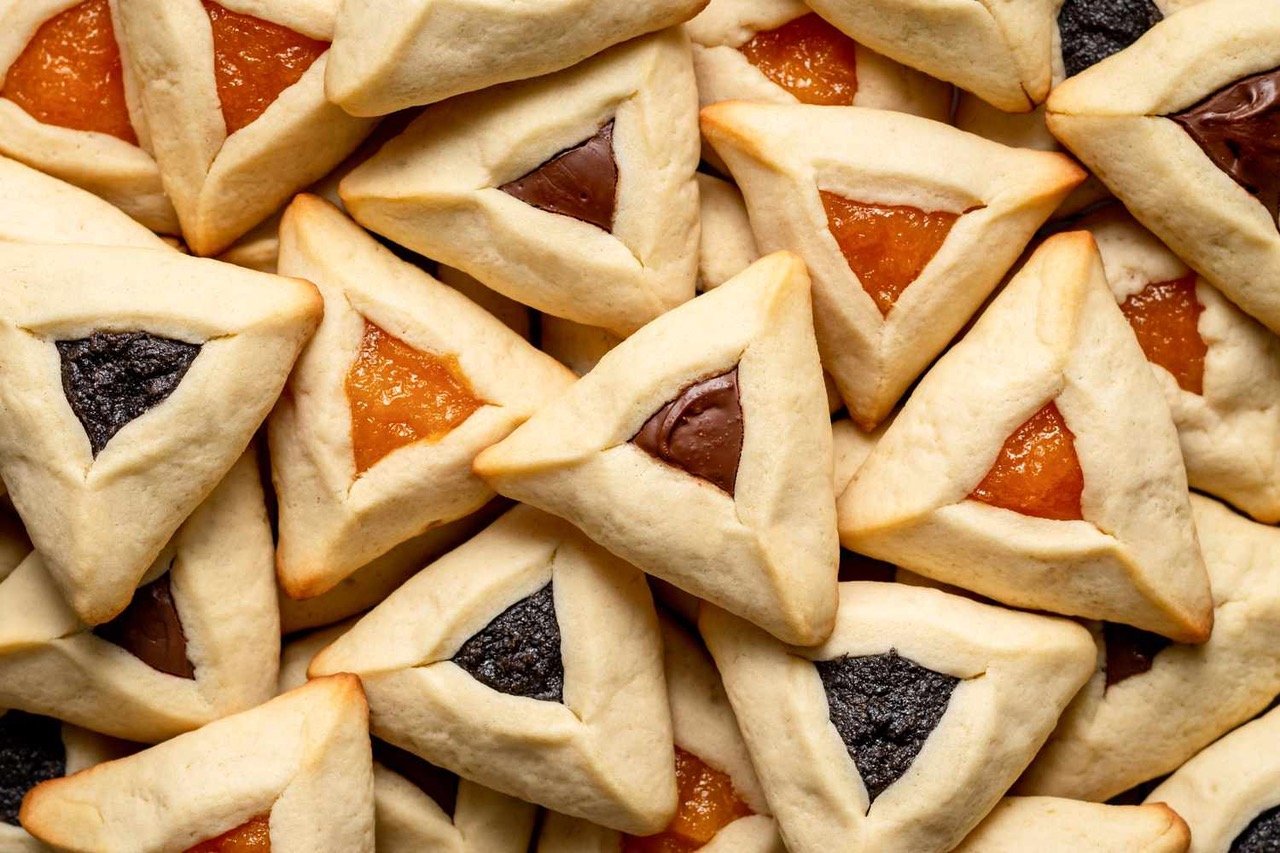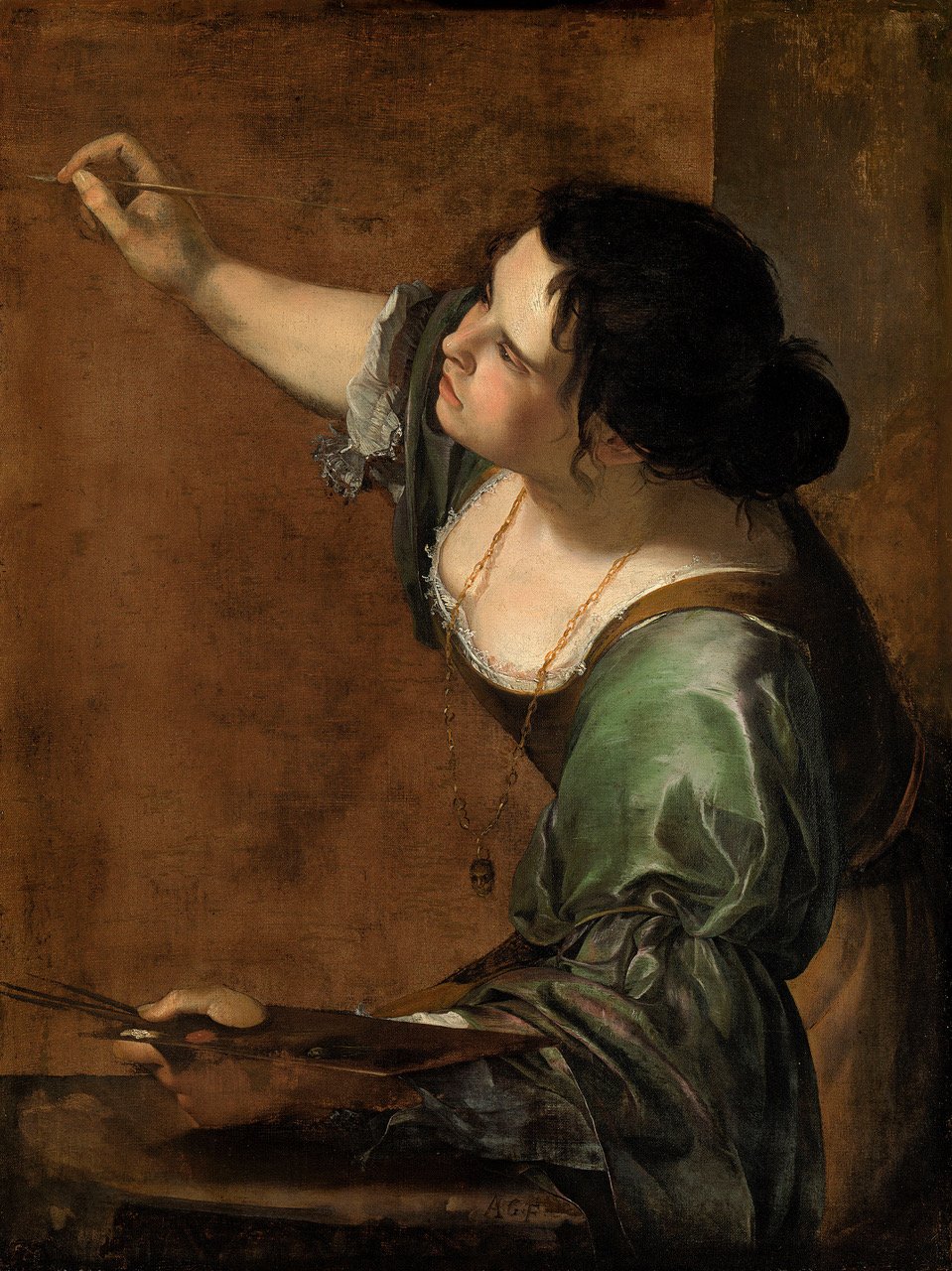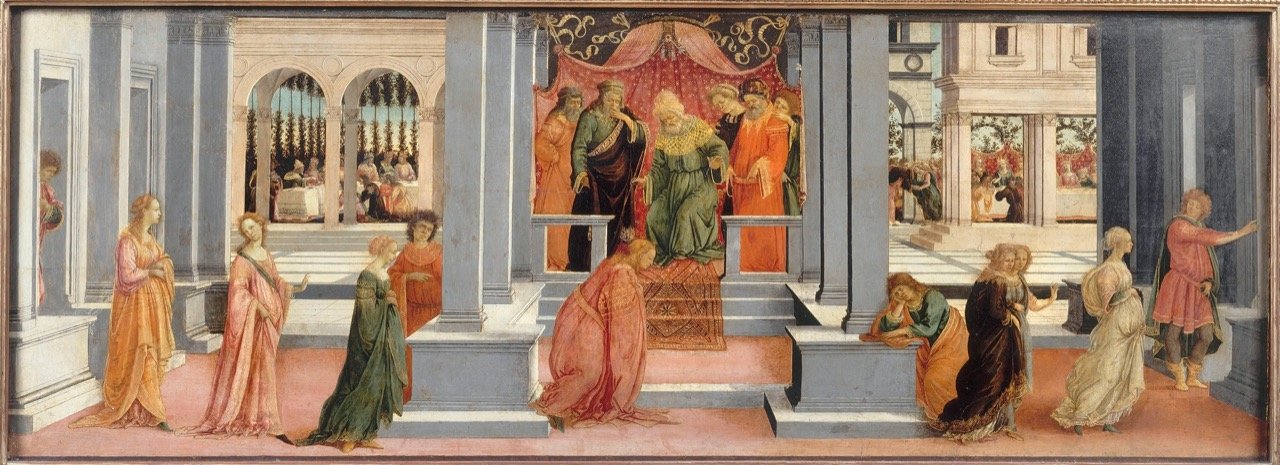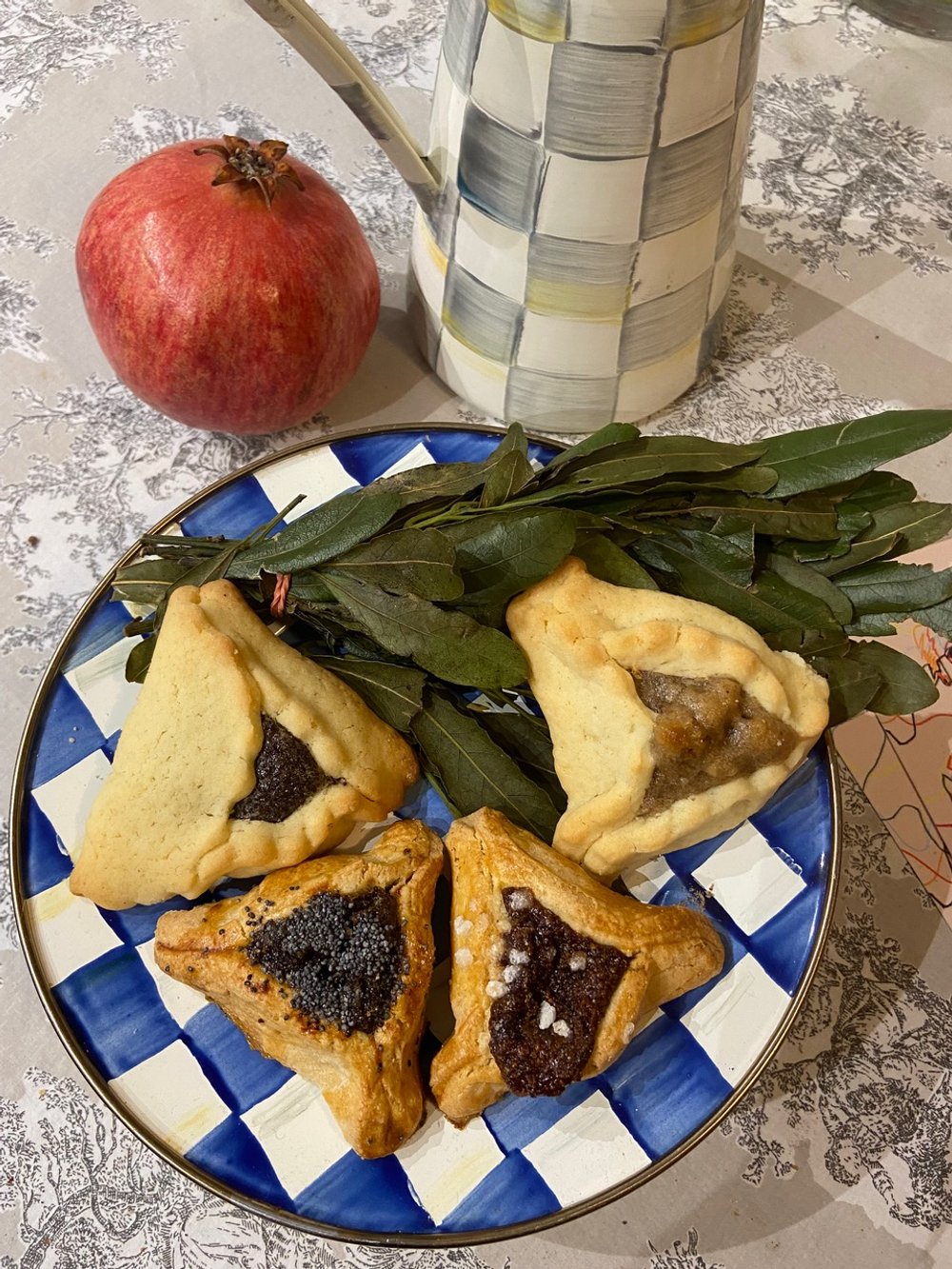Fêtes & Food
From Mardi Gras to Purim
I like fêtes. I like foods. As an art historian, I like images that depict the historical events surrounding a holiday and I like images of how people have come to celebrate those holidays. Food has often been my way of joining in the celebrations.
This year, February 21 was Mardi Gras (FR), Fat Tuesday (USA), Pancake Tuesday (UK). As I looked around for a food appropriate way to celebrate, the most readily available was the Italian deep fried sugar coated puffy cookie called chiacchiere. (Figure 1) So I walked over to Eataly and bought some. Which I ate. Which I enjoyed. Which I forgot to tell you about. Until now, until Purim. Another holiday with sweets and costumes and a direct link to Carnival, for which Mardi Gras is the last day.
Figure 1. Plate of Chiacciere, Italian deep friend sugar coated cookies for Mardi Gras
Some holidays, like Christmas, are celebrated on the same date each year because they are linked to the solar calendar. Mardi Gras, like all the significant days surrounding Easter, is based upon the lunar cycle of the Jewish calendar. We have the Church Fathers to blame for why Easter and Passover, even though they follow a lunar cycle, are not always celebrated at the same time. Although they occasionally are, like this year. Passover is from April 5 to April 13 and Easter is April 9. What does Easter have to do with Passover? Well, Christ’s Passion took place during Passover. His Last Supper was a Seder at which He and His disciples ate unleavened bread. (Figure 2) Purim and Passover? Purim is always celebrated a month before Passover.
Figure 2. Last Supper, from Maesta, Cathedral of Siena, Duccio, 1308-1311
Mardi Gras is the day before Ash Wednesday, the beginning of Lent. Ash Wednesday is celebrated 47 days before Easter. So Mardi Gras is 48 days before Easter. But wait, it gets confusing. Lent lasts from Ash Wednesday to Holy Thursday. That’s 38 days, not counting Sundays. Sundays are never counted because they are ‘little Easters,’ days to celebrate, not to do penance. But by adding Good Friday and Holy Saturday to the above mentioned 38 days, the number goes to 40.
Forty, like 3, 4, 7 and 12, is an important number in Christianity (we can talk about those other numbers another time). For 40, here are a few - Jesus was tempted for 40 days and 40 nights (Matthew 4:2, Figure 3). There were 40 days between Jesus' Resurrection and Ascension (Acts 1:3, Figure 4). And from our discussion about Punxsutawney Phil and Groundhog Day, Mary was required to wait 40 days after giving birth to Jesus until she was pure enough to Present her Son in the Temple. (Figure 5).
Figure 3. Temptation of Jesus, from Maesta, Cathedral of Siena, Duccio, 1308-1311
Figure 4. Ascension of Christ, J.S. Copley, (American, after Raphael) 1775
Figure 5. Presentation in the Temple, Arena Chapel, Padua, Giotto, 1305
Mardi Gras (Figures 6, 7) is a day of indulgence in anticipation of the weeks of penance ahead. The name Mardi Gras or Fat Tuesday, comes from the custom of using up all the fats in the house before all the fasting begins. And the joyous sounding word Carnaval? That’s from the Latin, carnelevare “to take out the meat,” to get rid of the meat. A rule that resonates with the Jewish one of ridding the household of all leavened products before the beginning of Passover. Lent’s restrictions are many - no meat, no sugar, no fats (including butter), no animal byproducts (including eggs and dairy). This may explain why, according to food historian Neil Buttery (great name, right?), so many dishes associated with Carnival feature butter and eggs and sugar - like pancakes in England, crepes and beignets in France, chiacchiere in Italy, brigadeiros (chocolate truffles) in Rio and King Cake (brioche) in New Orleans.
Figure 6. Carnival, Rio de Janeiro
Figure 7. Mardi Gras, New Orleans
Like most Christian holidays, Carnaval is based upon a holiday that was already in place. But which one? Maybe the Roman holiday Lupercalia, a festival of health and fertility (and the most likely precursor of St. Valentine’s Day) which was celebrated in mid-February. But it was probably Saturnalia, (Figure 8) celebrated in December. A holiday of gift giving and partying and a momentary overturning of social norms. For one day, slaves became masters and masters served slaves. At the end of the day of jocularity, it was over, masters once again asserted their control.
Figure 8. Saturnalia interpreted by Antoine-François Callet (1783)
There was a Christian precursor of Carnaval, too - the Feast of Fools. (Figures 9, 10) Like the Roman Saturnalia, it gave subordinates the opportunity to rule, for a while. The ancient Roman king for a day became the Christian Lord of Misrule. Criticism of the Church was tolerated, gambling was allowed and revelers dressed up. These festivals were not about offering an alternative to the established order, they were a way to let off steam. If anything, they served to strengthen the prevailing codes of conduct. After the festivities, everything went back to ‘normal’.
Figure 9. Pieter Brueghel, the Elder, Feast of Fools, Fight between Carnival and Lent, 1559
Figure 10. Pieter Brueghel, the Elder, Feast of Fools, Fight between Carnival and Lent, 1559, detail
Carnival replaced the Feast of Fools some time before the 13th century. Like Saturnalia and the Feast of Fools, Carnaval challenges the established order by temporarily scrambling the social hierarchy. And there is no easier (less threatening, less permanent) way to do that than with costumes. Hide your identity, elevate your status or reduce your rank. Carnival is Costumes and Celebrations! (Figure 11)
Figure 11. Mardi Gras, Paris
And now, here we are, a couple weeks into Lent and a couple of weeks before Easter and it’s Purim! With sweets to eat and costumes to wear. I used to think of Purim as Halloween-light: less candy, fewer costume options. But turns out, Purim has closer ties to the holiday to which it is closer in time, Carnival.
You’ll be happy to know that I found a Proust connection. The exhibition at the Musée d'Art et d'Histoire du Judaïsme, called ‘Marcel Proust. Du côté de la mère,’ had a section about Queen Esther, whose story is the Purim story. To remind you, the Persian King Ahasuerus (who you probably know as Xerxes I) married the beautiful Jewess, Esther. Mordecai, Esther's uncle, learned that the king’s advisor Haman was planning to massacre the Jews. Mordecai asked Esther to intercede on behalf of her people. Esther agreed even though asking for an audience with the King was tricky. If he didn’t want to see you, he could have you killed. But Ahasuerus was not angry. His young bride was beautiful. (Figure 12) Although he was surprised when she told him that she was Jewish. Esther begged Ahasuerus to spare her people. He did and Haman, (Figures 13, 14) the king’s evil advisor was hanged instead.
Figure 12. ‘Banquet of Esther,’ painting: Jean-François de Troy (1740), Gobelins Tapestry, 1778
Figure 13. ‘Esther Begging King Ahasuerus,’ painting Jean-François de Troy (1740) Gobelins Tapestry, 1778
Figure 14. 'Haman Condemned,' painting Jean-François de Troy (1740), Gobelins Tapestry, 1778
The images above are ones I saw at the Chateau de Roche Guyon, when I was there on a press junket for an exhibition on a Blake & Mortimer comic book which takes place at the chateau. Before I got to the comic books, I saw these tapestries. Which I obviously had to examine. Much to my surprise, they were scenes from the life of Esther based on paintings by the 18th century French artist, Jean-Francois de Troy. The tapestries had been commissioned by the Duchess of Enville, who owned the chateau and who was an enlightened aristocrat with liberal leanings. One historian suggests that the tapestries were a plea for religious tolerance. Not for the Jews of course, but for the Protestants in Catholic France.
Oh right, the Esther - Proust connection. At first I thought that it was simple - Esther was Jewish, Proust’s mother was Jewish. But turns out that Jeanne Proust was fond of Racine’s 1689 version of Esther’s tale, composed for the young ladies enrolled in the seminary at Saint-Cyr. In 1905, Sarah Bernhardt, (the inspiration for Proust’s Berma), staged Racine’s play (Figure 15) with all the roles performed by women, as they had been originally. Proust’s friend and lover, the musician Reynaldo Hahn wrote the music for Bernhardt’s performance, which was later performed chez Proust.
Figure 15. Sarah Bernhardt as Queen Esther
Before I tell you about the costumes and those cookies, I want to tell you about just one more painting of Queen Esther by an artist whose work I adore - Artemisia Gentileschi, (Figure 16) daughter of the artist Orazio Gentileschi. Here’s a bit of background: One day, an artist with whom her father worked, Agnostino Tassi, came to the Gentileschi home. Orazio was out. Artemisia was in. Tassi raped her. He told her he would marry her if she continued to have sex with him. When it became clear that Tassi had no intention of making good on his promise (turns out he was already married), Artemisia’s father took him to court. For violating the family’s honor! During the trial, Artemisia was tortured with thumbscrews, to make sure she was telling the truth.
Figure 16. Artemisia Gentileschi, Self Portrait as Painting
She’s famous for being an excellent artist, not for having survived a rape and trial. But the anger and rage and frustration she surely felt when she was put on trial for being raped, never went away. One of her strongest paintings shows a determined Judith hacking off the head of Holofernes. (Figure 17) Another painting, Susanna and the Elders, (Figure 18) shows the painful confrontation of powerful old men and an innocent young woman. Like the latter, Esther before Ahasuerus (Figure 19) isn’t physically violent, it’s melodramatic. As Met curator Keith Christiansen notes, Artemisia has “infused a well-known biblical story with her understanding of a gendered society in which women employed beauty and cleverness to gain the upper hand”.
Figure 17. Judith and her maidservant decapitating Holofernes
Figure 18. Susanna and the Elders, Artimesia Gentileschi
Figure 19. Esther before Ahasuerus, Artimesia Gentileschi
On the left, the lovely Esther, in décolleté, swoons in fear (she could be killed) and fatigue (she has been praying for 3 days). On the right, a crowned and behatted Ahasuerus, King of Persia, shows a lot of leg. Both are dressed in 17th century finery, especially the king, whose black and white striped knee length breeches stylishly match his puffy sleeves. Italian Renaissance artists often decorated cassone (marriage chests, Figure 20) with scenes from Esther’s life. She was an emblem of a virtuous and courageous bride. Artemisia’s Esther is “a believable woman, full of dignity, boldly risking all as she faces the young, capricious king.”
Figure 20. Italian Cassone (marriage chest) Esther before Ahasuerus
That’s Esther’s story. The celebration of her triumph is called Purim because Haman was going to cast lots to determine the best time to exterminate the Jews. The word for “lot” in Hebrew is pur, and the plural of pur is purim.
The costumes custom seems to have originated in 13th century Italy. Jews had been celebrating Purim for a millennia by the time Catholics began holding pre-Lenten carnivals. When girls started dressing up as Esther and boys starting dressing up as Mordechai or Ahasuerus or even Haman, it was up to the rabbis to justify it. This is what they came up with. Esther hid her Jewish identity from King Ahasuerus. Haman concealed his plot to kill Mordechai from the King. And since God is not mentioned in the Book of Esther, God’s role is "hidden". That’s what costumes do, they hide, they conceal. But, at the end of the day, it was more about seeing your neighbors partying and finding a way to do the same for one of your own holidays.
About the cookie. One April a few years ago, I walked by a kosher cafe/boulangerie called XXV. I looked in the window, it was filled with hamantaschen. They were much smaller than the ones I knew in the US. Was it because everything is bigger in the U.S.? This obviously needed investigating.
Turns out hamantaschen began as mohn taschen, a German pastry, popular since the middle ages. Mohn means poppy and taschen means pockets. In the late 1500s, German Jews changed the word mohn to Haman and the taschen became a reference to Haman's bribe filled pockets. But over time, Eastern Europeans decided that the taschen was really a three cornered hat, like the one Napoleon wore. When I asked the woman in the cafe why the pastries were so small, she told me that in France the cookies are in the shape of Haman’s ears. (Figure 21) In Israel, hamantashen are called oznei haman, also Haman's ears. Hat vs Ears might explain why the cookies are so large in the US and so small in France and Israel. Why is poppy seed the traditional filling? Because, to follow the laws of Kashrut (keeping kosher), Esther could only eat seeds, nuts and legumes in her husband’s traife palace. I still don’t know why prune (lekvar) the traditional Ashkenazi filling is not available in France. The re/search continues.
Figure 21. Hamantaschen from rue de Rosiers in the Marais - hats, ears, whatever …..
Copyright © 2023 Beverly Held, Ph.D. All rights reserved
Dear Reader, I hope you enjoyed reading this article. Please sign up below to receive more articles plus other original content from me, Dr. B. Merci!
And, if you enjoyed reading this review, please consider writing a comment. Thank you.





















